Spring Jpa Hibernate
In this section, you will learn about integrating Spring 3 MVC with Hibernate Jpa using a example.
The project structure is given below :
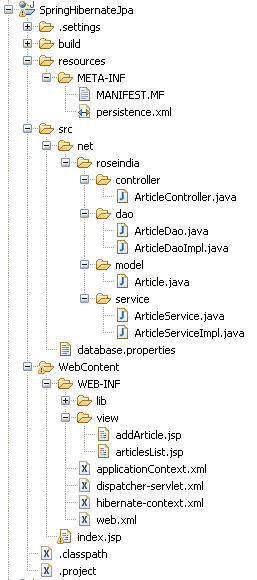
The jar file used is given below :
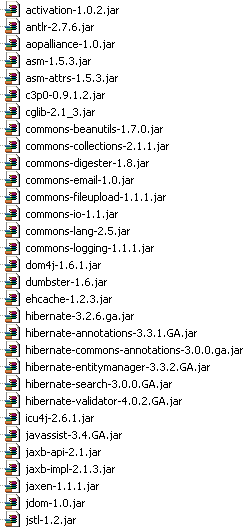 |
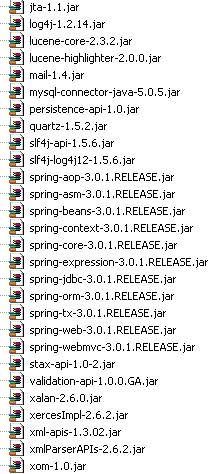 |
CODE
web.xml
<?xml version="1.0" encoding="UTF-8"?> <web-app xmlns:xsi="http://www.w3.org/2001/XMLSchema-instance" xmlns="http://java.sun.com/xml/ns/javaee" xmlns:web="http://java.sun.com/xml/ns/javaee/web-app_2_5.xsd" xsi:schemaLocation="http://java.sun.com/xml/ns/javaee http://java.sun.com/xml/ns/javaee/web-app_2_5.xsd" id="WebApp_ID" version="2.5"> <display-name>SpringHibernateJpa</display-name> <servlet> <servlet-name>dispatcher</servlet-name> <servlet-class>org.springframework.web.servlet.DispatcherServlet</servlet-class> <load-on-startup>1</load-on-startup> </servlet> <servlet-mapping> <servlet-name>dispatcher</servlet-name> <url-pattern>*.html</url-pattern> </servlet-mapping> <welcome-file-list> <welcome-file>index.jsp</welcome-file> </welcome-file-list> <listener> <listener-class> org.springframework.web.context.ContextLoaderListener </listener-class> </listener> </web-app>
The listener class ContextLoaderListener will load the applicationContext.xml automatically, if it is placed inside WEB-INF folder. If you want to place it anywhere other than WEB-INF, you can do this like this :
In the below, we are placing applicationContext.xml inside src folder as follows :
<context-param> <param-name>contextConfigLocation</param-name> <param-value>classpath:applicationContext.xml</param-value> </context-param> <listener> <listener-class> org.springframework.web.context.ContextLoaderListener </listener-class> </listener>
applicationContext.xml
<?xml version="1.0" encoding="UTF-8"?> <beans xmlns="http://www.springframework.org/schema/beans" xmlns:xsi="http://www.w3.org/2001/XMLSchema-instance" xmlns:context="http://www.springframework.org/schema/context" xmlns:mvc="http://www.springframework.org/schema/mvc" xsi:schemaLocation="http://www.springframework.org/schema/beans http://www.springframework.org/schema/beans/spring-beans-3.0.xsd http://www.springframework.org/schema/context http://www.springframework.org/schema/context/spring-context-3.0.xsd http://www.springframework.org/schema/mvc http://www.springframework.org/schema/mvc/spring-mvc-3.0.xsd"> <!-- Activates various annotations to be detected in bean classes --> <context:annotation-config /> <!-- Scans the classpath for annotated components that will be auto-registered as Spring beans. For example @Controller and @Service. Make sure to set the correct base-package--> <context:component-scan base-package="net.roseindia" /> <!-- Configures the annotation-driven Spring MVC Controller programming model. Note that, with Spring 3.0, this tag works in Servlet MVC only! --> <mvc:annotation-driven /> <!-- Load Hibernate related configuration --> <import resource="hibernate-context.xml" /> </beans>
hibernate-context.xml
<?xml version="1.0" encoding="UTF-8"?>
<beans xmlns="http://www.springframework.org/schema/beans"
xmlns:xsi="http://www.w3.org/2001/XMLSchema-instance"
xmlns:p="http://www.springframework.org/schema/p"
xmlns:tx="http://www.springframework.org/schema/tx"
xmlns:context="http://www.springframework.org/schema/context"
xsi:schemaLocation="
http://www.springframework.org/schema/beans
http://www.springframework.org/schema/beans/spring-beans-3.0.xsd
http://www.springframework.org/schema/tx
http://www.springframework.org/schema/tx/spring-tx-3.0.xsd
http://www.springframework.org/schema/context
http://www.springframework.org/schema/context/spring-context-3.0.xsd">
<context:property-placeholder location="classpath:database.properties" />
<tx:annotation-driven transaction-manager="transactionManager" />
<!-- Declare a datasource that has pooling capabilities-->
<bean id="dataSource" class="com.mchange.v2.c3p0.ComboPooledDataSource"
destroy-method="close"
p:driverClass="${database.driver}"
p:jdbcUrl="${database.url}"
p:user="${database.user}"
p:password="${database.password}"
p:acquireIncrement="5"
p:idleConnectionTestPeriod="60"
p:maxPoolSize="100"
p:maxStatements="50"
p:minPoolSize="10" />
<!-- Declare a JPA entityManagerFactory-->
<bean id="entityManagerFactory" class="org.springframework.orm.jpa.LocalContainerEntityManagerFactoryBean" >
<property name="persistenceXmlLocation" value="classpath*:META-INF/persistence.xml"></property>
<property name="persistenceUnitName" value="hibernatePersistenceUnit" />
<property name="dataSource" ref="dataSource"/>
<property name="jpaVendorAdapter">
<bean class="org.springframework.orm.jpa.vendor.HibernateJpaVendorAdapter" >
<property name="showSql" value="true"/>
</bean>
</property>
</bean>
<!-- Declare a transaction manager-->
<bean id="transactionManager" class="org.springframework.orm.jpa.JpaTransactionManager">
<property name="entityManagerFactory" ref="entityManagerFactory" />
</bean>
</beans>
If you are using C3P0 for connection pooling, the datasource bean should be configured as above but if you are using springframework default connection pooling, you should configure the datasource bean as follows :
<bean id="dataSource" class="org.springframework.jdbc.datasource.DriverManagerDataSource"> <property name="driverClassName" value="com.mysql.jdbc.Driver" /> <property name="url" value="jdbc:mysql://192.168.10.13/spring_ankDb" /> <property name="username" value="root" /> <property name="password" value="root" /> </bean>
persistence.xml
The persistence.xml file should be placed inside META-INF folder and this META-INF folder should be placed inside resources or src directory.
<persistence xmlns="http://java.sun.com/xml/ns/persistence" version="1.0"> <persistence-unit name="hibernatePersistenceUnit" transaction-type="RESOURCE_LOCAL"> <properties> <property name="hibernate.hbm2ddl.auto" value="none" /> </properties> </persistence-unit> </persistence>
dispatcher-servlet.xml
<?xml version="1.0" encoding="UTF-8"?> <beans xmlns="http://www.springframework.org/schema/beans" xmlns:xsi="http://www.w3.org/2001/XMLSchema-instance" xmlns:context="http://www.springframework.org/schema/context" xmlns:tx="http://www.springframework.org/schema/tx" xsi:schemaLocation=" http://www.springframework.org/schema/beans http://www.springframework.org/schema/beans/spring-beans-3.0.xsd http://www.springframework.org/schema/context http://www.springframework.org/schema/context/spring-context-3.0.xsd http://www.springframework.org/schema/tx http://www.springframework.org/schema/tx/spring-tx-3.0.xsd"> <bean id="jspViewResolver" class="org.springframework.web.servlet.view.InternalResourceViewResolver"> <property name="viewClass" value="org.springframework.web.servlet.view.JstlView" /> <property name="prefix" value="/WEB-INF/view/" /> <property name="suffix" value=".jsp" /> </bean> <!-- max upload size in bytes --> <bean id="multipartResolver" class="org.springframework.web.multipart.commons.CommonsMultipartResolver"> <property name="maxUploadSize" value="10000000"/> </bean> </beans>
database.properties
# database properties database.driver=com.mysql.jdbc.Driver database.url=jdbc:mysql://192.168.10.13/spring_ankDb database.user=root database.password=root
index.jsp
Given below the welcome JSP file which is displayed by web.xml automatically :
<%@ page language="java" contentType="text/html; charset=ISO-8859-1" pageEncoding="ISO-8859-1"%> <!DOCTYPE html PUBLIC "-//W3C//DTD HTML 4.01 Transitional//EN" "http://www.w3.org/TR/html4/loose.dtd"> <html> <head> <meta http-equiv="Content-Type" content="text/html; charset=ISO-8859-1"> <title>Spring 3 MVC and Hibernate JPA Example</title> </head> <body> <h2 style="font-style: italic">Spring 3 MVC and Hibernate JPA Example</h2> <ul style="font-size: 20px;"> <li><a href="articles.html">List of Articles</a></li> <br/> <li><a href="articles/add.html">Add Article</a></li> </ul> </body> </html>
The java interfaces and classes (controller & service classes) used in the example is given below :
(Click on the below package name to view the interfaces / classes contained by the packages )
The JSP files use for view pages are given here(Click below link to view):
OUTPUT
When you execute the above code, you will get the following welcome page :
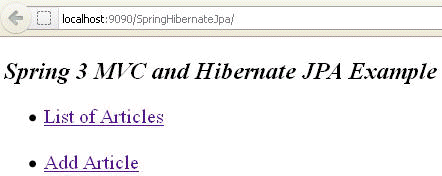
When you click on List of Articles , you will get the following page :
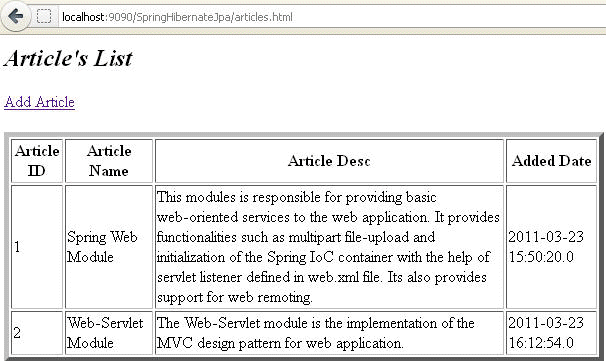
When you click on the Add Article , you will get the following page for adding new Articles :
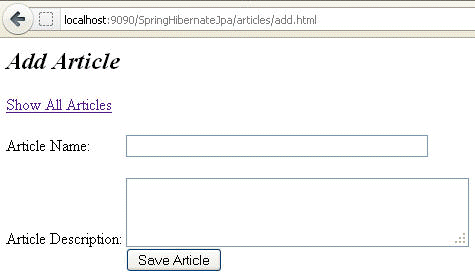
You can download the source code from the below Hyperlink :
